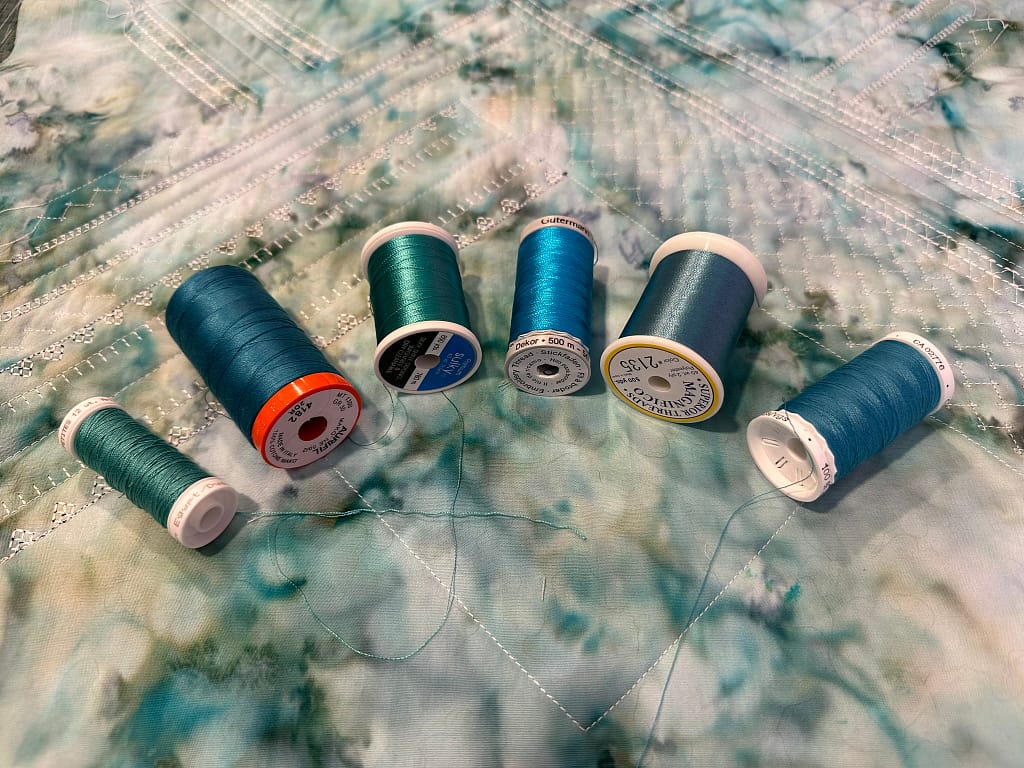Let’s start with the elephant in the room. Most people use cotton fabric for their quilts. The myth that polyester thread cut cotton fabric is just that with today’s threads. If you don’t believe me, ask the manufacturers!
Ok, now that I have gotten that off my chest. We can talk about picking the type of thread for your project. We will talk weight and colors in another post.

There are five main thread types for quilting: cotton, polyester, silk, wool, and rayon. In no particular order, let’s talk about each of them. The image has two cotton threads on the left, two rayon threads in the middle, and two polyester threads on the right. You can see the variations in the sheen, thickness and overall appearance.
Polyester
Polyester thread is probably one of the most common used today. It is the strongest of the threads mentioned. This means that you can get it in a variety of thicknesses without worrying about breakage.
That strength makes it great for durability. Your seams will stay strong. You may even be able to use it for beading (nylon is probably the best for that application though).
Polyester threads also have some give or s-t-r-e-t-c-h to them.
These threads also have good colorfast properties. Meaning, they don’t fade like more natural threads do.
The sheen on a polyester thread can be much different than a natural thread. This means it will be more noticeable. That may or may not be a good thing, depending upon the project.
It is synthetic. So, if you are worried about sustainability, it might not be your best choice.
What does all this mean? If you are making a quilt that will get washe
Silk is the next strongest thread.
It is a dream to work with most of the time. The ends can fray a little, which is why bees wax is a good thing to have on hand.
Silk has a nice stretch to it.
The sheen and feel of silk great for special projects. Silk comes in a wide variety of colors. However, it is not as reliable as polyester for keeping its color. But it is better than cotton or wool.
Silk is relatively sustainable and durable.
The downside of silk is the cost!
What does this mean? Silk is wonderful for heirloom projects.
Wool
Wool has the middling strength.
Wool is fun for projects because it is generally a thicker thread. It has a nice texture and comes in plenty of colors. It is not as color fast as silk.
It is quite sustainable. It also wicks moisture away rather than absorbing it like cotton does.
The downside is similar to silk – the COST.
What does this mean? Wool is good for special projects.
Cotton
Cotton is sturdy, but not necessarily strong compared to the others. that sturdiness unfortunately means that it isn’t as flexible as the other options.
Like the other two natural materials. It has a lovely texture and blends well with fabric. Also like the other two natural materials, it tends to split in the needle.
Cotton does shed quite a bit depending on the twist.
It has loads of color options. Yet, it does fade in the sun.
It is relatively inexpensive compared to silk and wool. So, it is a good option for natural threads in MOST PROJECTS.
Rayon
Rayon is the weakest of the threads. But it has a beautiful luster, which is why it is used for so many embroidery projects. It does not do well for piecing.
It is a synthesized from plant materials. Rayon absorbs water quickly, which is why it isn’t very strong. That water absorbing capability also means it biodegrades easily.
Rayon comes in a wide variety of colors.
It is significantly less expensive than silk. This makes it a great alternative for silk for decorative purposes.
Summary
There are other thread options out there. But these five are the primary ones in use for quilting type projects.
We hope this quick summary helps you pick the best thread for your project.
Stay tuned for the next installment… we will be talking about thread sizes.
Happy Quilting
